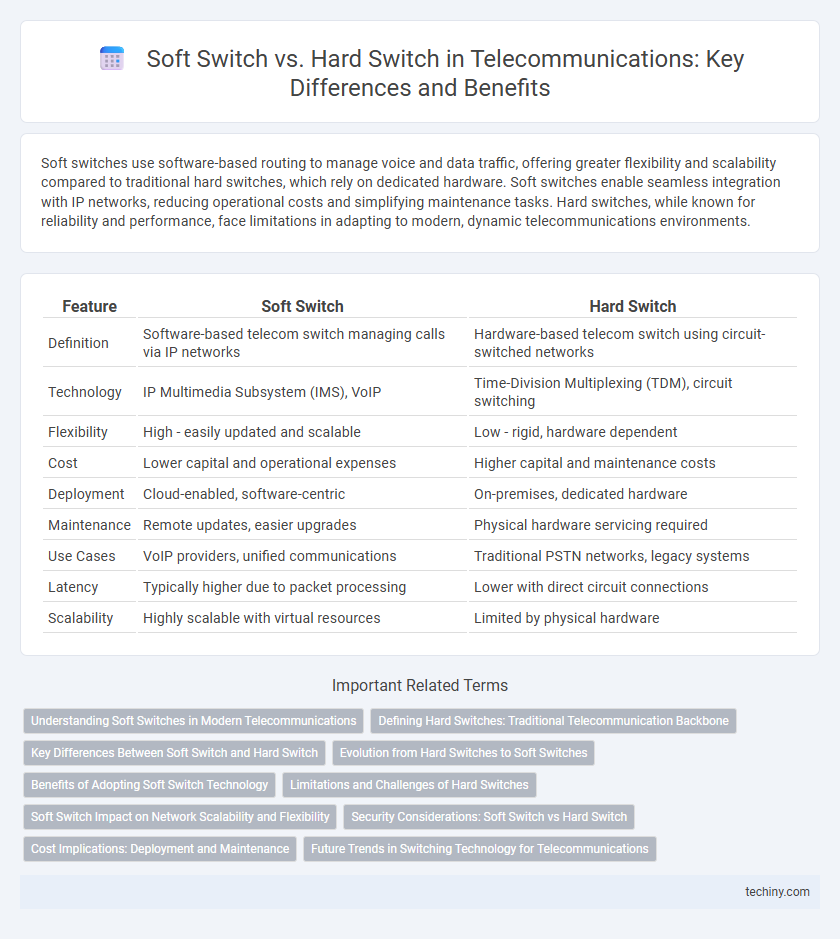Soft switches use software-based routing to manage voice and data traffic, offering greater flexibility and scalability compared to traditional hard switches, which rely on dedicated hardware. Soft switches enable seamless integration with IP networks, reducing operational costs and simplifying maintenance tasks. Hard switches, while known for reliability and performance, face limitations in adapting to modern, dynamic telecommunications environments.
Table of Comparison
| Feature | Soft Switch | Hard Switch |
|---|---|---|
| Definition | Software-based telecom switch managing calls via IP networks | Hardware-based telecom switch using circuit-switched networks |
| Technology | IP Multimedia Subsystem (IMS), VoIP | Time-Division Multiplexing (TDM), circuit switching |
| Flexibility | High - easily updated and scalable | Low - rigid, hardware dependent |
| Cost | Lower capital and operational expenses | Higher capital and maintenance costs |
| Deployment | Cloud-enabled, software-centric | On-premises, dedicated hardware |
| Maintenance | Remote updates, easier upgrades | Physical hardware servicing required |
| Use Cases | VoIP providers, unified communications | Traditional PSTN networks, legacy systems |
| Latency | Typically higher due to packet processing | Lower with direct circuit connections |
| Scalability | Highly scalable with virtual resources | Limited by physical hardware |
Understanding Soft Switches in Modern Telecommunications
Soft switches in modern telecommunications manage voice, data, and multimedia traffic through software rather than hardware, enabling greater flexibility and scalability in network management. These software-based switches facilitate seamless integration with IP networks, reducing dependency on traditional circuit-switched hardware and lowering operational costs. Utilizing protocols such as SIP and MGCP, soft switches enhance call control capabilities and support advanced services like VoIP, unified communications, and network virtualization.
Defining Hard Switches: Traditional Telecommunication Backbone
Hard switches serve as the traditional telecommunication backbone, managing circuit-switched networks by physically connecting calls through dedicated hardware. These switches operate with fixed, hardware-based architectures that establish and maintain call paths, ensuring reliable voice communication across legacy Public Switched Telephone Networks (PSTN). Their robustness and low latency make them critical in scenarios requiring guaranteed connection quality and minimal delay.
Key Differences Between Soft Switch and Hard Switch
Soft switches manage voice and data traffic through software-based control, enabling flexible and scalable network configurations, while hard switches rely on physical hardware for call routing and signal processing. Soft switches facilitate IP telephony integration and support advanced features like VoIP and multimedia services, contrasting with hard switches that primarily handle traditional circuit-switched networks. The key difference lies in soft switches' programmability and virtualization capabilities versus the fixed-functionality and dedicated hardware design of hard switches.
Evolution from Hard Switches to Soft Switches
The evolution from hard switches to soft switches marks a significant leap in telecommunications, shifting from hardware-based circuit switching to software-driven packet switching that enables more flexible and scalable network management. Soft switches leverage IP protocols to route calls and manage multimedia sessions, reducing costs and enhancing interoperability across diverse network architectures. This transition supports the convergence of voice, video, and data services, facilitating the deployment of modern VoIP and unified communication solutions.
Benefits of Adopting Soft Switch Technology
Soft switch technology enhances telecommunications by enabling flexible, software-driven call control that reduces reliance on physical hardware. This approach lowers operational costs, simplifies network management, and allows rapid deployment of new services through virtualization. Soft switches improve scalability and integration with IP-based networks, fostering seamless support for VoIP and unified communications.
Limitations and Challenges of Hard Switches
Hard switches in telecommunications face significant limitations such as inflexibility in adapting to new protocols and scalability challenges due to their rigid hardware design. Maintenance and upgrades require physical intervention, leading to higher operational costs and longer downtimes compared to software-based systems. Furthermore, hard switches struggle with integrating modern IP-based services, limiting their effectiveness in converged network environments.
Soft Switch Impact on Network Scalability and Flexibility
Soft switches significantly enhance network scalability and flexibility by leveraging software-based control to manage voice and data traffic, enabling seamless integration with IP networks and cloud platforms. Their ability to dynamically allocate resources and support virtualized environments reduces dependency on physical hardware, facilitating rapid expansion and adaptation to changing network demands. This contrasts with hard switches, where fixed hardware architecture limits scalability and adaptability in evolving telecommunications infrastructures.
Security Considerations: Soft Switch vs Hard Switch
Soft switches offer enhanced security through centralized control and software-based encryption protocols, enabling rapid updates and vulnerability patches to counter emerging threats. Hard switches rely on physical circuit connections, providing inherent protection against certain types of cyberattacks but often lack flexibility in implementing security features or updates. Evaluating security considerations between soft and hard switches involves balancing software adaptability with hardware robustness to ensure resilient telecommunications infrastructure.
Cost Implications: Deployment and Maintenance
Soft switches reduce deployment and maintenance costs by leveraging software-based architectures that operate on standard servers, eliminating the need for expensive proprietary hardware associated with hard switches. Hard switches involve higher upfront capital expenditure and ongoing maintenance expenses due to their specialized physical infrastructure and complex circuit-switching technology. Telecom operators benefit from soft switch flexibility, which lowers operational costs and simplifies network upgrades, improving return on investment.
Future Trends in Switching Technology for Telecommunications
Soft switches enable more flexible, software-driven network management and integration with IP-based communications, driving the transition toward fully virtualized telecom infrastructures. Hard switches, traditionally hardware-centric, are increasingly supplemented or replaced by soft switch architectures to support scalable, cloud-native environments that improve operational agility and reduce costs. Future trends emphasize AI-enhanced switching, network function virtualization (NFV), and 5G integration, which collectively optimize real-time data routing and service delivery in next-generation telecom networks.
Soft Switch vs Hard Switch Infographic

 techiny.com
techiny.com